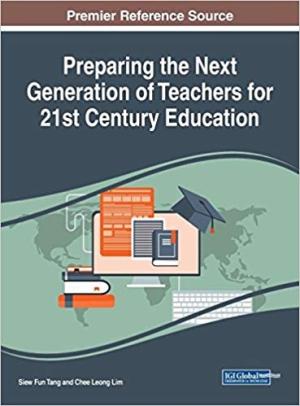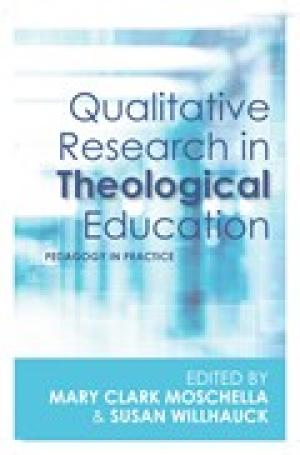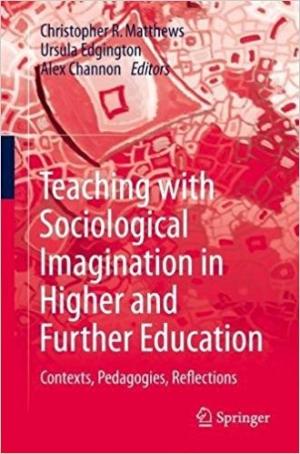Resources

Gaming technologies have become effective learning tools within education. Gamification has the potential to increase engagement using real-time feedback on learning activities, which allows students to reflect on their completion and retention of a learned activity. Gaming Innovations in Higher Education: Emerging Research and Opportunities is an essential reference work featuring the latest scholarly knowledge on the application of different gaming techniques within education to make learning activities more enjoyable and successful. Including research on a number of topics such as virtual laboratories, interaction media, and intrinsic and extrinsic motivation, this publication is ideally designed for academicians, researchers, and students interested in the benefits of providing an entertaining and intellectually-stimulating learning environment. (From the Publisher)

As educational standards continue to transform, it has become essential for educators to receive the support and training necessary to effectively instruct their students and meet societal expectations. To do this, fostering education programs that include innovative practices and initiatives is imperative. Preparing the Next Generation of Teachers for 21st Century Education provides emerging research on innovative practices in learning and teaching within the modern era. While highlighting topics such as blended learning, course development, and transformation practices, readers will learn about progressive methods and applications of 21st-century education. This book is an important resource for educators, academicians, professionals, graduate-level students, and researchers seeking current research on contemporary learning and teaching practices. (From the Publisher)

In Teaching for Purpose, Heather Malin explores the idea of purpose as the purpose of education and shows how educators can prepare youth to live intentional, fulfilling lives. The book highlights the important role that purpose—defined as “a future-directed goal that is personally meaningful and aimed at contributing to something larger than the self”—plays in optimal youth development and in motivating students to promote the cognitive and noncognitive skills that teachers want to instill. Based on a decade of research conducted at the Stanford University Center on Adolescence, the book explores how educators and schools can promote purpose through attention to school culture, curriculum, project learning, service learning, and other opportunities. Malin argues for expansive thinking on the direction schools should take, especially in terms of educating students to be creative, innovative, and self-directed critical thinkers. The book includes profiles of six organizations working in schools across the US that have made purpose development a priority. Infused with the engaging voices of purposeful youth, Teaching for Purpose offers a fresh, inspirational guide for educators who are looking for new ways to support students to succeed not only in school, but in life. (From the Publisher)

Click Here for Book Review What are the foundational moments of meaningful scholarship of teaching and learning (SoTL) projects? How do teacher-scholars collect, develop, and share useful insights about student learning? How do they work through the pinch points that frustrate, confuse, or elude many SoTL practitioners? By unpacking SoTL processes through rich narratives that illustrate what they look like, this collection offers inspiration to anyone at any stage of engagement with SoTL. This book takes discussions of SoTL to a new level. Its subtitle reflects the microscopic lenses SoTL processes can apply to student learning experiences to understand how they happen, what they look like, what they mean, and what we can do about them. Going beyond definitions, how-to, theory, and debates about methods and standards, the contributors offer a SoTL primer documenting how practitioners have intentionally thought through key moments in their work. These procedural vignettes present powerful examples of what doing SoTL looks like when done well. The authors represent a range of disciplines (the humanities, social sciences, natural sciences, and professions) and a mixture of familiar and unfamiliar names. Nancy Chick has selected contributions that compellingly illuminate why their authors focused on a particular critical moment, the questions they asked as they refined their approaches, and the theoretical and observational tools they employed to conduct their research. Each introduces a specific critical moment in doing SoTL, taking the reader through the author’s reflections, concerns, and choices in doing meaningful SoTL work. The aim is to support potential practitioners, inform educational developers who teach new SoTL practitioners, and inspire experienced SoTL scholars to reflect on their own practice. This is a compelling collection for anyone interested in practitioner reflection, intentional design, and advancing the field of SoTL and the quality of teaching and learning. (From the Publisher)

Click Here for Book Review Even on good days, teaching is a challenging profession. One way to make the job of college instructors easier, however, is to know more about the ways students learn. How Humans Learn aims to do just that by peering behind the curtain and surveying research in fields as diverse as developmental psychology, anthropology, and cognitive neuroscience for insight into the science behind learning. The result is a story that ranges from investigations of the evolutionary record to studies of infants discovering the world for the first time, and from a look into how our brains respond to fear to a reckoning with the importance of gestures and language. Joshua R. Eyler identifies five broad themes running through recent scientific inquiry—curiosity, sociality, emotion, authenticity, and failure—devoting a chapter to each and providing practical takeaways for busy teachers. He also interviews and observes college instructors across the country, placing theoretical insight in dialogue with classroom experience. (From the Publisher)

Advocates for the rights of people with disabilities have worked hard to make universal design in the built environment “just part of what we do.” We no longer see curb cuts, for instance, as accommodations for people with disabilities, but perceive their usefulness every time we ride our bikes or push our strollers through crosswalks. This is also a perfect model for Universal Design for Learning (UDL), a framework grounded in the neuroscience of why, what, and how people learn. Tobin and Behling show that, although it is often associated with students with disabilities, UDL can be profitably broadened toward a larger ease-of-use and general diversity framework. Captioned instructional videos, for example, benefit learners with hearing impairments but also the student who worries about waking her young children at night or those studying on a noisy team bus. Reach Everyone, Teach Everyone is aimed at faculty members, faculty-service staff, disability support providers, student-service staff, campus leaders, and graduate students who want to strengthen the engagement, interaction, and performance of all college students. It includes resources for readers who want to become UDL experts and advocates: real-world case studies, active-learning techniques, UDL coaching skills, micro- and macro-level UDL-adoption guidance, and use-them-now resources. (From the Publisher)

Click Here for Book Review Teaching Readers in Post-Truth America shows how postsecondary teachers can engage with the phenomenon of “post-truth.” Drawing on research from the fields of educational and cognitive psychology, human development, philosophy, and education, Ellen C. Carillo demonstrates that teaching critical reading is a strategic and targeted response to the current climate. Readers in this post-truth culture are under unprecedented pressure to interpret an overwhelming quantity of texts in many forms, including speeches, news articles, position papers, and social media posts. In response, Carillo describes pedagogical interventions designed to help students become more metacognitive about their own reading and, in turn, better equipped to respond to texts in a post-truth culture. Teaching Readers in Post-Truth America is an invaluable source of support for writing instructors striving to prepare their students to resist post-truth rhetoric and participate in an information-rich, divisive democratic society. (From the Publisher)

Click Here for Book Review Qualitative Research in Theological Education brings together a diverse group of scholars to consider the theological values arising from and contributing to their use of qualitative research in scholarship and teaching. The book offers a careful consideration of the pedagogical and administrative challenges involved in teaching qualitative research and its various sub-disciplines such as ethnography. As a whole, the book argues that the teaching of QR methods is critical to the theological, ethical, spiritual, and/or pastoral formation of ministers and theological scholars. (From the Publisher)

With a laudable personal openness and deep dedication to both their field of sociology and the practice of teaching, editors Christopher R. Matthews, Ursula Edgington, and Alex Channon premise their volume Teaching with Sociological Imagination in Higher and Further Education on the idea that the skills of reflexivity and critical thinking are not only skills they stress in their courses to train and develop students, but also skills that can and should inform their own teaching practice. This reflective nature is the guiding purpose of their essay collection, and the contributors therein address that same principle from a variety of angles. Such a reflexive approach, the editors write in their own section of the volume, “Introduction: Teaching in Turbulent Times,” is emphasized as “an exploration of the importance of teaching with sociological imagination, derived from a critical, reflexive engagement with our own situated practices, theorizations, and professional identities” (xvii). This openness regarding the positionality of the researcher and of the teacher is in large part what sets this volume apart. Briscoe (2005, Educational Studies 38, 23-41) noted that ideological positioning grants that while ideologies derive from one’s experiences and are influenced by one’s demographic positionality, the researcher (and in this case, the teacher) can have experiences that allow him or her to develop empathy with the other (33). The fact that Matthews, Edgington, and Channon foreground this idea sets the tone for the rest if the volume. For instance, James Arkwright’s essay focuses on education equality as seen through the lens of inclusion and accessibility. The case studies Arkwright includes illustrate the issues and themes of students confronted with short- and long-term illnesses, as well as disabilities, and their experiences in institutions of higher or further education. These cases are built upon by his own story of being an educator who uses a wheelchair, through which he even more strongly makes his case for why the current state of inclusivity may seem positive, while the reality of those inclusive policies in practice could be improved to achieve a greater degree of equity. Another demonstration of the efficacy of the volume’s premise is Pam Lowe’s entry on the role emotions may play in the learning experience. This topic is timely, as debates on trigger warnings and how or whether to address sensitive issues in class is ongoing. Lowe explores the complexity of educators’ attempts at balancing emotional and sensitive issues with academic objectivity. Teaching with Sociological Imagination in Higher and Further Education is a valuable collection of topics from a variety of professional angles, all focused on how educators teach reflexivity and critical thinking, while practicing those same principles as educators. In doing so, Matthews, Edgington, and Channon have provided a strong and diverse contribution to the fields of sociology and education, as well as a demonstration of the value inherent in exploring, understanding, and practicing how these fields are interlinked.

Going Online presents a hopeful view of online teaching. A professor in the NYU Tanden School of Engineering, Ubell seems aware that this position will contradict many professors’ perceptions. “Sitting at desks or moving about, our bodies and minds inhabit the classroom, often with the same ease and familiarity we find at home,” he writes, adding “Most of us assume it’s the ideal learning environment” (33). Going Online makes a case for recognizing the limitations of the face-to-face classroom and reconsidering the pedagogical practices that become possible outside of that setting. The collection might not persuade administrators and faculty whose familiarity with online education has led them to resist its expansion. However, it offers a useful survey of previous research and confronts pervasive misconceptions. These two features make it a valuable resource for sustaining conversations in universities looking to develop online experiential learning. In Chapter 1, “Dewey Goes Online,” Ubell writes, “Virtual education emerges as a workshop in which online students exercise functions essential for scholarship and professional life” (5). The professor’s role changes in an online setting because they “become facilitators, propelling students to engage in discourse through discussion and argument to generate and link ideas.” The move to an online format “often calls upon faculty to become far more engaged than in the classroom” (8). Going Online develops these two ideas – online courses facilitate active and experiential learning, and faculty become more dynamic and effective when teaching online – through theoretical discussion and practical applications. Going Online makes a point to dispel myths and misconceptions about online courses. Far from alienating or isolating students, online discussions unfold over time and provide space for reflection and “room for analysis, critique, and problem-solving” (9). The collection convincingly shows that the quality of online education equals or surpasses that of face-to-face instruction, but Ubell does not address the legitimate fears that can be summarized in one professor’s observation: “Machines have historically been used to increase profits by cutting the labor force” (54). In fact, part of faculty resistance stems from the low status attached to online courses. In “Why Faculty Don’t Want to Teach Online,” Ubell acknowledges that teaching online represents a risk for many untenured faculty. Those who contemplate migrating their courses online must confront the potential suspicion of colleagues. Ubell explores possible concerns such as “Will she be devalued, suspect, even ridiculed?” “Will her career be threatened?” and “Will she be exposed to hostile reactions from her colleagues?” (50). Alternatively, “will she be seen by some as adventurous, a risk-taker, an early adapter, unafraid of challenges?” (51). Going Online does not reassure teachers facing these risks, but this section asks faculty and administrators to confront the ways that prejudice against online education disadvantages those who shoulder those courses out of necessity or curiosity. These questions name problems and assumptions that might otherwise remain submerged in many conversations about program design. Ubell also acknowledges that the history of online education offers cautionary tales. “For years, for-profits dominated online industry” and greed turned many of those schools into “diploma mills” (55). Because of this history, many faculty at private and public universities fear that embracing online education means their institutions “will fall into the same contemptible void” (55). Ubell asks faculty to reframe this debate over online teaching: “the battle is not fought between brick-and-mortar and new digital space, but between old and new ways of teaching – between wise, old talking heads at the blackboard versus new approaches that encourage interaction among students and instructor” (55). However, learning to view the shift online in these terms is unlikely to satisfy the concerns of junior or contingent faculty worried about their status in the university; it will also do little to satisfy established faculty worried about how online programs will affect the status of their university. Ubell does not always take faculty objections to online teaching as seriously as I believe those objections merit, potentially limiting the reach and effectiveness of the collection. The concrete advice in Going Online will be particularly useful for academic programs or departments that are only now beginning to offer online courses. Chapter 3, “Active Learning,” by John Vivolo, Director of Online and Virtual Learning at the Tanden School, outlines technologies that make possible engaged discussions and interactive lectures. Chapter 7, “Migrating Online,” written with Sloan Foundation and Online Learning Consortium advisor A. Frank Mayadas, outlines the stages of designing an online program and situating it with an existing university structure. The strongest passages of the collection are those that describe the texture of an online class and acknowledge the practical needs that online programs meet. Mayadas writes: Schools that enter the online marketplace find that the largest fraction of students enrolling in their new online programs is drawn from nearby communities . . . Expect at first that most of your virtual student population will be regional – local students who are just as attracted to your programs as those who enroll on campus, but given various obstacles, are prevented from coming to campus. (70) Online courses are certainly more accessible to many students, and Mayadas asks readers to consider whether they may be more equitable too. For example, “Are women – who now make up a far greater proportion of students online than men – more likely to participate actively than in conventional male-dominated classrooms? What about the effectiveness of online learning for black, Hispanic, and other underrepresented students”? (69). Going Online does not elaborate on this point or explore these questions. Future researchers may want to take up this “next – and far more difficult – phase of quantifying the value of online learning” (69). As an early-career academic with experience designing and teaching online courses in rhetoric, composition, and literature, I recognized many of the advantages and pleasures that Ubell describes. In my experience, discussions that unfold online rather than in the classroom include more students and encourage careful thought rather than quick opinions. Often, online students who are geographically dispersed and working according to their own schedules are even more engaged than face-to-face students who display “eagerness, attention, and alertness” but “may just be performing according to conventional classroom rules” (48). Humanities teachers will likely bristle at some of Ubell’s descriptions of the face-to-face classroom, though. I share Ubell’s enthusiasm for online teaching and creative disruption, but I wondered if his dismissal of the conventional classroom as “artificial, often a space for listening, rarely open to practice and reflection,” reflects his experience in large lecture courses and the discipline of engineering (4-5). Many professors in the humanities build both online and face-to-face courses around critical reflection, active and peer-to-peer learning, and ethical argument. We would dispute the claim that “nothing has changed since Victorian times when classrooms and factories were built with pretty much the same purpose – for a docile workforce” (45). While this description runs counter to the experiences of many teachers, Ubell’s image of online courses will encourage readers who hope this growing form of education maintains the joy and rigor that propels our work.
Wabash Center Staff Contact
Sarah Farmer, Ph.D
Associate Director
Wabash Center
farmers@wabash.edu